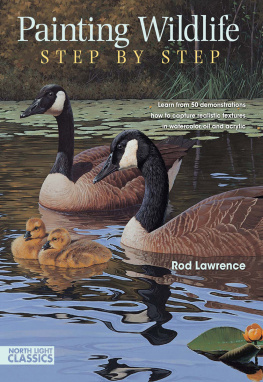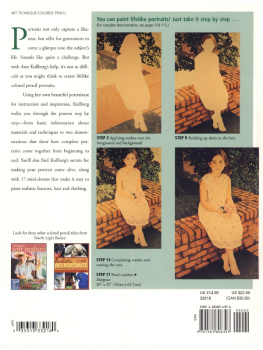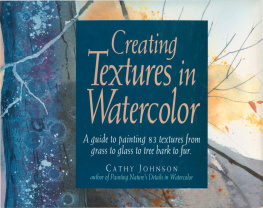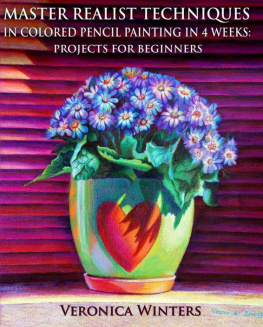DRAWING REALISTIC
TEXTURES IN PENCIL
J.D. HILLBERRY
To my wife, Vicki, and my children, Taylor and Logan, for tolerating my absence during the writing of this book.
Contents
CHAPTER ONE
Materials
Discover all the materials youll need to get
started and learn how to use them,
CHAPTER TWO
Tips and Techniques
Learn tips that show you how to keep your
drawing clean, ways to hold your pencil, and
ways to observe light and how it affects texture.
Step-by-step demontrations teach you techniques
for basic strokes, blending, combining
media, rubbing, indenting and masking.
CHAPTER THREE
Draw Realistic Objects
Seven step-by-step demonstrations teach you
how to create the textures for old pitted metal,
reflective metal, peopleincluding eyes, skin
and hairglass, weathered wood, leather,
barbed wire, and tips for drawing textures of
clothing and fur.
CHAPTER FOUR
Put It All Together in a Still Life
Follow along with two full-length, detailed,
step-by-step demonstrations to create beautiful
drawings.
Introduction
The key to rendering the look of any texture begins with your eyes. Before you can simulate surface textures you must learn to recognize them. Look up from this book and glance around. There are as many types of textures as there are colors. Feel the slick paper of this page you are reading. Now touch a piece of your clothing. You can feel a textural difference.
If you wanted to include this page and the fabric of your clothes in a realistic drawing, you would need to render the essential qualities that make paper look like paper and fabric look like fabric. Exaggerating the texture of your clothing enhances the look of the smoothness of the paper. I use this theory of opposites to heighten the realism in my work.
To make a texture look smoother, place it next to a rougher one; to make white look whiter, place it next to a dark value. No matter what your subject, adding texture and contrast also adds depth and realism to your drawings.
BIG LEAGUE DREAMS
Charcoal and graphite on Arches 140-lb. (300gsm) watercolor paper
10" 22" (25cm 55cm)
Photo by Richard Stum
In my view, drawings fall into two categories: contour line drawings and tonal drawings. A line drawing delineates the edges of a form. It is void of the shading that produces a three-dimensional look. Many line drawings are sensitive, finished pieces of art, but I prefer to add light, shadow and texture in my work. I begin with a line drawing, but only as the skeleton that holds the values and textures. It is an important part of drawing realistically, however.
To get the most out of this book, you should have some knowledge of how to draw the contours of the shapes you see. If the proportions and perspective are incorrect, adding texture and shading will not make it look real. The most common problem when attempting realism is letting the skeleton show through in the finished piece. The real world does not have lines encircling the outer edges of objects, so avoid hard outlines in your drawings.
CHAPTER ONE
Materials
All it takes to draw is a pencil and a piece of paper. This thought amazes me when I look around at all the materials I have accumulated while exploring numerous drawing techniques. Ive discovered that by using a variety of pencils, blenders and erasers you can increase the realism in your drawings. The good news is that all of the items I routinely use are inexpensive compared to the price of working with other media, and many traditional art stores let you experiment with pencils and paper before you buy them.

LUCKY DRAW # 2
Charcoal, graphite and carbon on Crescent watercolor board
21" 1712" (52.5cm 17.5cm)
Photo by Richard Stum
Pencils
By taking advantage of the inherent qualities found in three basic types of pencils, you will automatically increase the range of values that are possible and add more texture to your drawings.
Graphite Pencils
Artist-grade graphite pencils are more refined than your old no. 2, allowing for smoother lines on the paper. These pencils come in a wide range of hardness and softness and are labeled with letters and numbers. Pencils with the letter B are the softest. The higher the number in front of the B, the softer the pencil. The softest graphite pencil available is 9B, which produces the darkest line. Harder pencils make lighter marks and are noted with the letter H, with 9H being the hardest. Hard pencils are best for fine detailed work because they hold a sharp point better. A pencil with the letter F has a degree of hardness halfway between the H and B. There are many brands of graphite pencils. A 2B pencil of one brand may be vastly different than the 2B of another brand. I use Berol Turquoise drawing pencils.

Berol turquoise graphite pencil
Charcoal Pencils
Many people who are used to the feel of graphite effortlessly gliding across their paper find charcoal too abrasive. Several years ago, I came across Ritmo charcoal pencils. They combine the blackness of charcoal with the smoothness of graphite. They are available in degrees of hardness ranging from HB to 3B. Other brands of charcoal pencils work just as well, although they create a slightly different texture. All charcoal pencils smudge easily, so if youre not familiar with this medium read the section .

Ritmo charcoal pencil
Carbon Pencils
I use two different types of carbon pencils: Wolffs and Cont carbon. They both come in several degrees of hardness and, like other pencils, are labeled with the letters H and B. The Wolffs carbon pencil has recently been reformulated to give a smoother feel and richer blacks than the old version. It reflects light differently than charcoal and graphite. Cont carbon is made of graphite and clay. The clay gives it a warmer tone than either charcoal, graphite or Wolffs carbon. When either of these carbon pencils are used in combination with the other media, their inherent characteristics make them ideal for separating subjects containing similar values.

Wolffs carbon pencil

Cont carbon pencil
Graphite Sticks
Graphite sticks simply contain the graphite in a block shape. This allows you to use the broad edge to lay in large areas of tone. They are usually available only in the softer B range of graphite.
Charcoal Sticks













